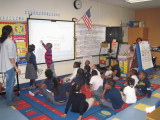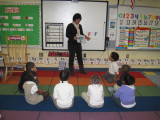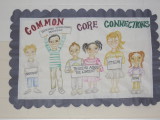-
Category 2
Selected in 2013
-
Grades: pre k - 6
School Setting: urban
Town Population: 1,508
Student Enrollment: 428
Student Demographics:
Black/African American: 83%
Teacher/Student Ratio: 1:22
White/Caucasian: 0%
Hispanic: 16%
Hawaiian/Pacific Islander: 0.2%
Asian: 0.5%
Native American: 0%
Other: 0%
% Reduced Lunch: 85%
% ELL Learners: 10%
Founded: 2001 -
PRINCIPAL:
Cheryl Franklin -
CONTACT:
4949 Addison Road
Capitol Heights, MD 20743
301-636-8400
Cheryl.Franklin@pgcps.org
Robert R. Gray Elementary School
Capitol Heights, MD
We adopted student conferencing to hold conversations with students around goal setting and gauging student progress. Additionally, we utilize Student Based Bulletin Boards which post student work based upon standards, but also incorporate substantive teacher feedback on the work that speaks directly to how the student met the standard.
- Describe specific programs in place to ensure that families are involved in the success of your school and students.
- Involving parents is essential to our academic success! Academic focus events are held during the day and evening to accommodate various work schedules. Grade Levels and Departments create parent websites to provide academic information and post instructional videos to orient parents on current skills. Parent Focus Walks are held to encourage parents to visit classrooms to analyze varied elements of instruction. Climate surveys are distributed to collect and analyze qualitative data to provide feedback and next steps to improve the academic program. The Parent Policy and Home School Compact are developed with parental participation and distributed yearly. Parents serve as volunteers during school events and assist with securing community and business partnerships. A Parent Resource Center is housed at the school to provide community supports and information about various parent/student programs. A Parental Involvement Committee meets monthly along with the PTA to receive school-wide information and to determine how they can best support the school program. Newsletters, school website, call outs, etc. continue to keep parents informed about events at the school.
- Describe the most successful activity your school has initiated to strengthen ties to your community.
- Each year our goal is to increase our community and business partnerships to support our academic program. Our community and business partners have supported our literacy initiatives by providing students with books to build their at home libraries. Additionally, one community and business partner has sponsored our Environmental Education Club by securing presenters to hold sessions and field trips with students around environmental awareness and conservation. Additional partners have supported our mission of community outreach by allowing our students to partner in Walking Against Homelessness and collecting food and toiletries for local pantries. Further, our partners have sponsored college tours to support our initiative of college and career ready students. Finally, our partners have served as volunteers for our Career Day events and assisted with securing additional volunteers to assist as well in the STEM careers.
- Describe your philosophy of school change or improvement.
-
As leaders of educational programs, school leaders must embrace organizational dynamics and strategic planning they desire to effect change within their educational organization. Marzano writes that among the twenty-one responsibilities of school leaders, involvement in curriculum, instruction, and assessment are essential. The knowledge of such components require that the school leader be directly involved in the design and implementation of curriculum, instruction, and assessment practices in order to effect significant change. School change can only occur if all stakeholders are clear about the school vision and how all decisions, resources, and instructional delivery are dedicated to ensuring the continued academic progress of students. Further, in a climate of change, it is essential to ensure a culture of transparency, input, and dialogue in all stages of the improvement process. Finally, it is essential that everyone must speak and live the vision in all that occurs each day.
- What are your school’s top two goals for the next year?
- Our first goal is to continue to support ownership around Maryland's College and Career Ready Standards through focused professional development, professional learning communities, sessions to build parental capacity around content standards, peer observation protocols, building student fluency around mathematical practices, and increasing the implementation of performance tasks across multiple content areas. Our second goal is to remain committed to partnering with our community to develop learners who become independent life-long learners, explorers of information, and critical thinkers able to demonstrate and verbally support their thought process.
- What is the single most important factor in the success of your school that others could replicate?
- Collaborative Planning Sessions! The most important factor for us has been to plan with purpose and to proceed with purpose. In everything we do, we plan to put forth our best, and proceed with purpose and vision. Our collaborative planning sessions are opportunities where we plan, share our most effective instructional practices, are honest about our progress, plan instruction, know specific students and their data by name, reflect upon our instruction/progress, prescribe interventions and/or enrichment opportunities, and dialogue about modifications moving forward. There is so much power giving individuals opportunities to reflect upon the instructional process, and supporting a culture that encourages focused reflection and dialogue.
- Describe the program or initiative that has had the greatest positive effect on student achievement, including closing achievement or opportunity gaps, if applicable.
- Over the past few years we had the opportunity to serve as an America's Choice School. Through this, we adopted student conferencing to hold conversations with students around goal setting and gauging student progress. Additionally, we utilize Student Based Bulletin Boards which post student work based upon standards, but also incorporate substantive teacher feedback on the work that speaks directly to how the student met the standard. Further, our 25 Books Campaign serves as a school-wide effort to encourage and celebrate the independent reading of students based upon specific genre study. Accountable talk protocols have motivated students to orally express their thinking and to respectfully challenge the thought process of peers through the use of substantive evidence. Classrooms are rich with posted artifacts that support student learning, but also serve as a reference point during instructional conversations in the classrooms.
- Explain how Title I funds are used to support your improvement efforts.
-
Title I funding sources have been a great support to our overall instructional program. First, our Title I funds are used to purchase multiple instructional resource materials to supplement our instructional program. Second, we have been able to purchase technology that has made it possible to house a computer lab, mobile lab, Interwrite boards in each classroom, and student response systems. These funds have also been useful in providing funding for professional development for staff both locally and nationally. School staff have been able work collaboratively in professional learning communities to participate in book studies to strengthen professional learning that has translated into classrooms. Finally, this funding has supported parental involvement initiatives through providing books for parent book studies, fund presenters for parent learning opportunities, to pay for registration fees for parental attendance at state and local conferences.
- Identify the critical professional development activities you use to improve teaching and student learning.
-
There have been several areas we have pledged to strengthen as continuing adult learners. First, we have dedicated time to becoming exemplary around data analysis by building proficiency around the use of multiple sources of evidence to gauge student progress. Second, we have strengthened our understanding of differentiated instruction and how to modify instruction to meet the needs of diverse learners. Third, we have hosted sessions to understand, support, and increase the achievement of at-risk learners. Fourth, we have expanded our knowledge of technology integration and how it can be used to differentiate and supplement instruction and be used as a tool to strengthen parental communication. Fifth, we have implemented our learning of STEM instruction and how to integrate its use across all content areas. Finally, professional development has been used to develop rich math tasks using a variety of instructional strategies to support kinesthetic learning as well as, the use of manipulatives to strengthen skill retention.
- Describe how data is used to improve student achievement and inform decision making.
-
Data analysis is the core of every decision we make in servicing our students! Instructional teams meet bi-weekly to analyze student work through our Collaborative Analysis of Student Learning protocol. Through this, teams are able to use student work samples to determine how students are progressing with skills, focus on specific strengths and/or weaknesses based upon the samples, and determine how this translates into moving forward instructionally. Additionally, we use student diagnostic data to determine instructional safety nets, both prior to and during the school day, that will be used to provide intervention and/or enrichment to move students to higher levels of performance. Further, we use data to implement a school-wide intervention and enrichment block where all students are engaged in focused instruction to address areas of weakness or to strengthen their understanding of key skills and concepts. Finally, our data is used to determine differentiated professional development opportunities to support our instructional program.
- Describe your school culture and explain changes you’ve taken to improve it.
-
Our school culture is one built on collaboration. Much thought, planning, and preparation must occur when structuring “adaptive work” that has the ability to impact an organization's habits, attitudes and beliefs. When considering that your work may shift humanistic behaviors – patience and clarity must be present. It is essential that all stakeholders feel comfortable sharing how their work can improve the overall organization and how their role contributes to our continued success. To support this, we began to hold regular roundtables with all stakeholders (cafeteria, custodial, paraprofessionals, instructional, etc.) to ensure they felt as though their contributions matter and that they are clear around the vision and mission. Everyone has an important role - and that is improving the academic success of our students. We speak it and believe it.
Stats
-
Category 2
Selected in 2013
-
Grades: pre k - 6
School Setting: urban
Town Population: 1,508
Student Enrollment: 428
Student Demographics:
Black/African American: 83%
Teacher/Student Ratio: 1:22
White/Caucasian: 0%
Hispanic: 16%
Hawaiian/Pacific Islander: 0.2%
Asian: 0.5%
Native American: 0%
Other: 0%
% Reduced Lunch: 85%
% ELL Learners: 10%
Founded: 2001 -
PRINCIPAL:
Cheryl Franklin -
CONTACT:
4949 Addison Road
Capitol Heights, MD 20743
301-636-8400
Cheryl.Franklin@pgcps.org










